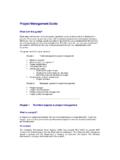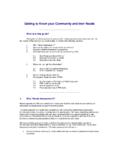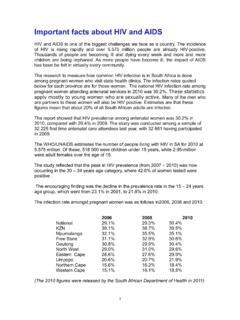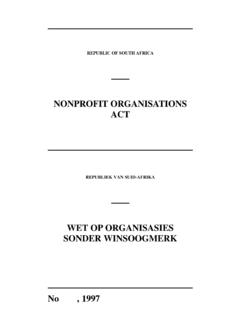Transcription of Government spending and income - ETU
1 Government spending and income What is in this guide This guide contains an explanation of the national budget as well as the income sources for Government revenue. It has the following sections: 1. Government spending overview 2. Main expenses 3. Government income sources 4. Increasing Government income Government spending overview Every year Government spends billions of rand on providing a better life for our people. In 2009/10, the budget for Government spending was R773 billion. (A billion is one thousand tim es a m illi on and looks l i ke thi s: R1 000 000 000).
2 An additional R55 bil lion was to be spent on debt service and R6 billion was kept as a contingency reserve for emergencies. This made a total of R834 billi on The pie chart below shows how most of the money in the national budget was spent in the previous financial year of 2008/9. It is shaped like a cake or a pie and the slices are different sizes to show how much each budget item gets. The size of the slices or percentages does not change much from year to year and the total budget amount is usually increased by more or less the same percentage as inflation.
3 BUDGET 2008/9education17%welf are15%health11 %housing7%protection13%water and agric4%other15%transport and communication10%debt8% The total budget for 2008/9 was R716 billion. Of this amount R55 billion was allocated for debt. spending and budgeting occurs within a medium term expenditure framework (MTEF), which projects income and expenditure for three years. Government has little flexibility to make major changes within the budget since most costs are fixed and recurring for example salaries, rent and equipment. When more revenue is raised than planned for, it is usually spent on once-off priority programmes such as infrastructure development or above inflation increases for specific categories of staff (for example nurses or police officers).
4 2. Main spending items Debt Debt interest at 8% of our total income is a heavy burden on the total Government revenue. The payments we make on interest are for the debts we inherited from apartheid as well as new loans. In 1996 debt was our biggest budget item at over 20%. Government borrows m oney from time to ti me for thi ngs li ke buil di ng big i nfrastructure l i ke dam s that cost billi ons and cannot be paid from the budget for one year. These loans come from banks and institutions like the World Bank. Some people argue that we should not pay the apartheid debts since they were not made by a democratic Government , but there are good reasons why we are paying them.
5 Firstly most of the money the previous Government borrowed belonged to South African banks and insurance companies. They lent the Government money that ordinary people had saved or invested with them for pensions, insurance and benefits. If we refuse to pay the interest, those people would lose their money and Government would have to look after them. If we refuse to pay the money we owe to foreign banks, we will get a bad credit record and no-one will lend us money in the future. Education Education is the biggest item in the budget and it makes up 17% (one sixth) of the pie.
6 We spend a lot on education because we are still paying for some of the backlogs from the past. Many of our schools still need classrooms, toilets, sports fields and equipment. Salaries of teachers make up about three quarters of the education budget. We have a large proportion of young people in South Africa - around one third of our people are children. Social we lfare Social welfare at 15% is the second biggest part of Government expenditure. Welfare includes all the social grants, old age pensions and poverty relief work of Government . Over the last 9 years, the number of people who get social grants has grown from just over 3 million to over 12 million.
7 That is about one quarter of the people in South Africa. He alt h Health takes up 11% - more than one tenth of our budget. The Government health budget pays for free health care for children and pensioners, as well as for unemployed people. With almost half the people in South Africa living under the poverty line and almost 20% of adults HIV p o si ti ve , sta te he al th pl a ys a ve ry im po rtan t rol e. Housing Housing (7%) has been a priority for Government in the last 10 years and more than m illi on houses have been subsi di sed by state fundi ng si nce 1994.
8 Pr ote ction Protection services have a budget that is around 13% of national spending and includes police, courts and prisons as well as the Defence Force and Intelligence Services. The safety budget has increased over the last few years to deal with crime because Government has prioritised this issue. Defence (about 4%) spending is much less than it was under Apartheid and this is one of the categories where the percentage spending has decreased almost every year since democracy started. Econom ic development Wi thout economi c devel opment we cannot create more j obs, and will not deal with the long term causes of poverty.
9 Communication and transport (10%) and water and agriculture at (4%) are big spending items that pay for many of the massive new infrastructure projects and for developing the farming sector. Some other economic development services also fall under the category Other . Examples are small business development, industrial development and loans to small and medium businesse s. Other Apart from economic services Other covers transfers to local Government and many other Government departments. It also coves the costs of parliament, provincial legislatures and all other public servants who do not fall under any of the other categories listed here.
10 Contingency rese rve and budge t re view Government must budget for around 1% contingency reserve for emergency and unforeseen expendi ture. Hal fway through the budget year a review will be done by the Mi ni ster of Fi nance to check how much of the reserve is unspent. The unspent budget for the first six-month period will be re-allocated to departments that have overspent or have developed new needs. Equitable share National Government receives all the revenue collected by SARS and distributes most of it to provinces for spending on the big items like education and health.



